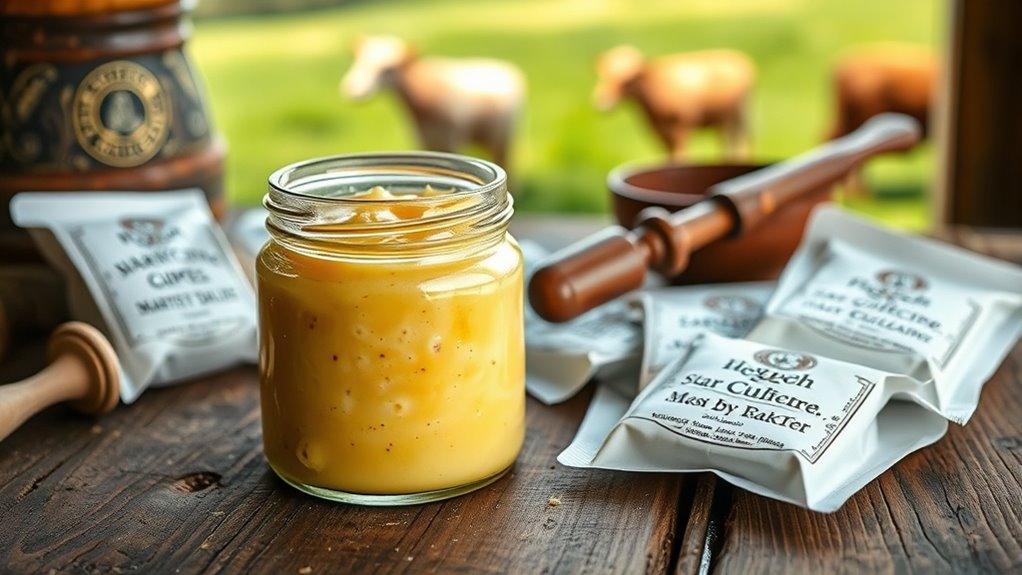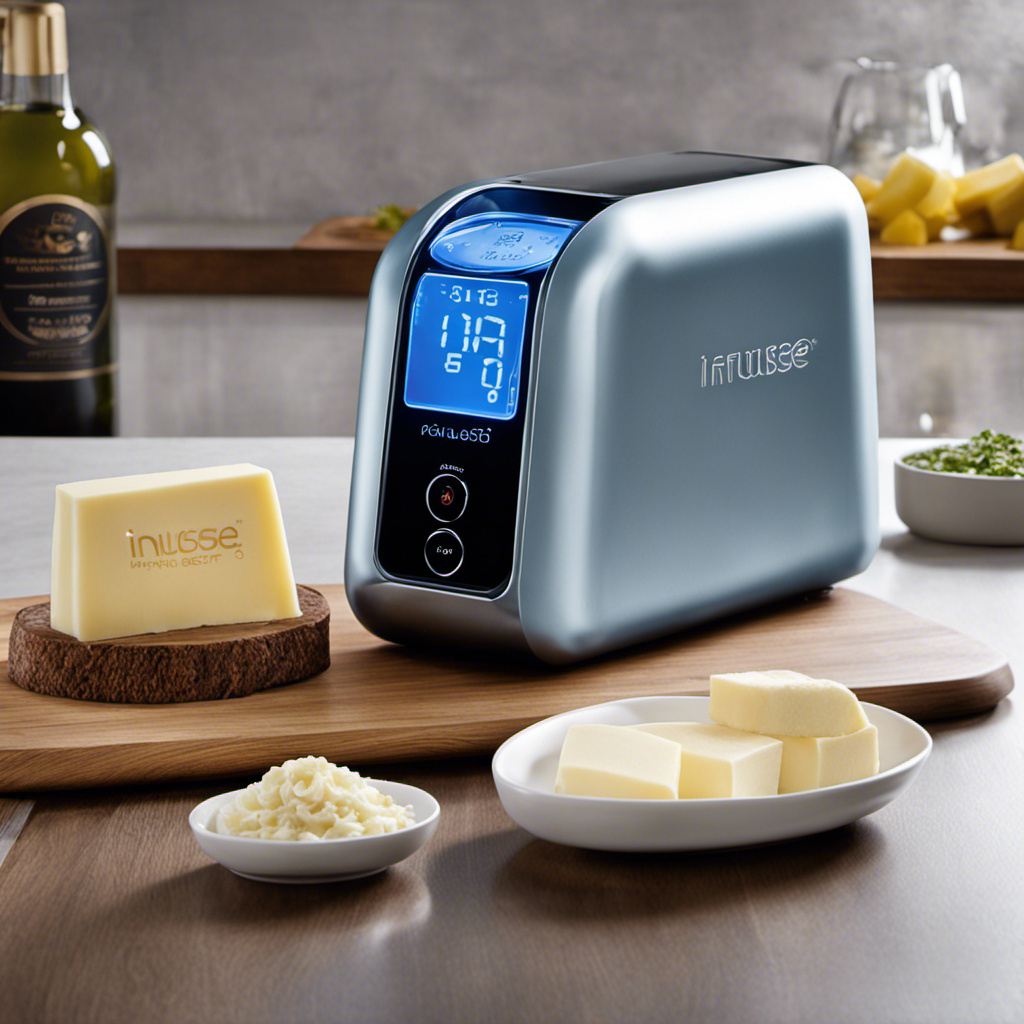Starter cultures are essential in European-style butter because they guide fermentation, influencing flavor, texture, and safety. They contain beneficial bacteria and enzymes that break down lactose and fats, producing rich flavors and smooth textures. These cultures also help prolong shelf life and prevent spoilage. By carefully selecting and applying the right cultures, you guarantee consistent quality and authentic characteristics in your butter. If you want to discover how these cultures can elevate your butter, keep exploring further.
Key Takeaways
- Starter cultures initiate controlled fermentation, developing traditional flavors and textures unique to European-style butter.
- They produce acids, esters, and aromatic compounds that enhance flavor complexity during processing.
- Cultures improve butter consistency, smoothness, and spreadability by influencing fat crystallization and protein networks.
- They inhibit harmful pathogens, ensuring safety, freshness, and extended shelf life of the final product.
- Standardized cultures promote consistency, reliability, and preservation of traditional qualities in European-style butter.
Understanding Starter Cultures in Dairy Production
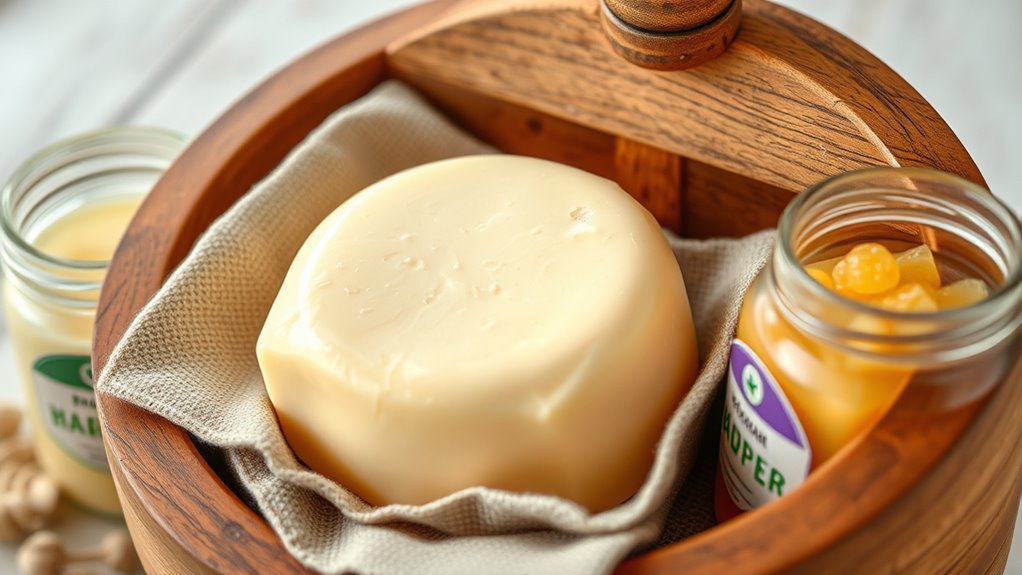
Understanding starter cultures in dairy production is essential because they directly influence the flavor, texture, and safety of the final product. During dairy fermentation, specific microorganisms are added to milk to initiate controlled fermentation processes. These cultures consist of a diverse mix of bacteria that drive the transformation of milk into butter, cheese, and other dairy products. Microbial diversity plays a vital role, as different strains contribute unique flavors, acidity levels, and textures. By selecting the right starter cultures, you can guarantee consistent quality and safety, minimizing spoilage risks. The use of vetted starter cultures ensures the reliability and safety of dairy products. Whether for traditional European butter or modern dairy, understanding how these cultures work helps you optimize fermentation, control flavor profiles, and produce a high-quality product that meets consumer expectations.
Types of Microorganisms Used in Butter Making

The microorganisms used in butter making primarily consist of specific bacteria and enzymes that initiate fermentation and influence the final product’s quality. Lactic acid bacteria play a crucial role by fermenting lactose into lactic acid, which helps develop flavor and texture. These bacteria include species like Lactococcus lactis and Leuconostoc mesenteroides, which contribute to acidity and aroma. Yeast fermentation is also involved, especially in traditional methods, where yeast helps produce subtle flavor nuances and improve butter stability. You’ll find that these microorganisms work together to enhance the butter’s consistency, aroma, and taste. By carefully selecting and managing these microbial cultures, you can craft high-quality European-style butter with distinct characteristics. Understanding their roles is essential for consistent, flavorful results. Microbial cultures are carefully maintained to ensure optimal fermentation and flavor development.
The Fermentation Process and Flavor Development

Fermentation is a vital step in developing the rich, complex flavors characteristic of European butter. During the fermentation timeline, beneficial microbes break down milk sugars and fats, producing a variety of flavor compounds. This process typically spans several hours to days, depending on temperature and culture activity. As fermentation progresses, these microbes generate acids, esters, and other aromatic molecules that contribute depth and nuance to the butter’s flavor profile. The formation of specific flavor compounds is closely linked to fermentation conditions, making precise control indispensable. You’ll notice the flavor intensify and develop complexity over time, reflecting the microbial activity at each stage. Proper fermentation ensures a balanced, authentic taste, capturing the traditional qualities prized in European-style butter. Additionally, understanding the fermentation process can help producers optimize flavor development and consistency.
Impact of Starter Cultures on Texture and Consistency
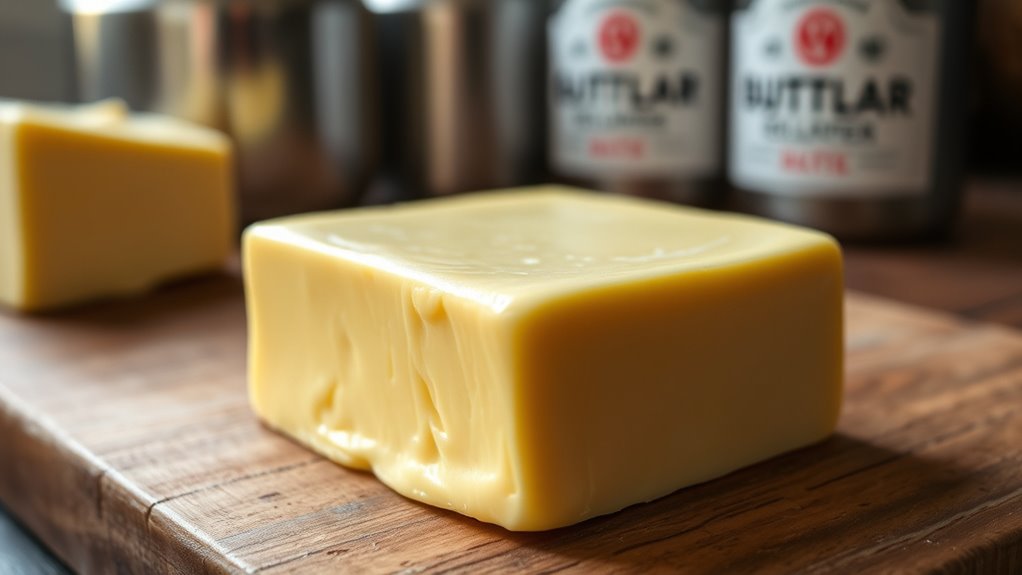
Starter cultures directly influence the texture and consistency of European butter by shaping the way milk fats and proteins interact during processing. They promote texture enhancement by encouraging the formation of a smoother, creamier structure, making the butter more appealing. Additionally, these cultures help with consistency control, ensuring each batch maintains uniform firmness and spreadability. By producing specific enzymes and acids, starter cultures modify fat crystallization and protein networks, resulting in a more desirable texture. The influence of culture strains extends to color accuracy, affecting the visual appeal of the final product. Your choice of culture strains can lead to a butter with a richer mouthfeel or a firmer hold, depending on the desired outcome. Overall, starter cultures are essential for achieving the precise texture and consistency that define high-quality European-style butter.
Enhancing Shelf Life and Food Safety Through Cultures
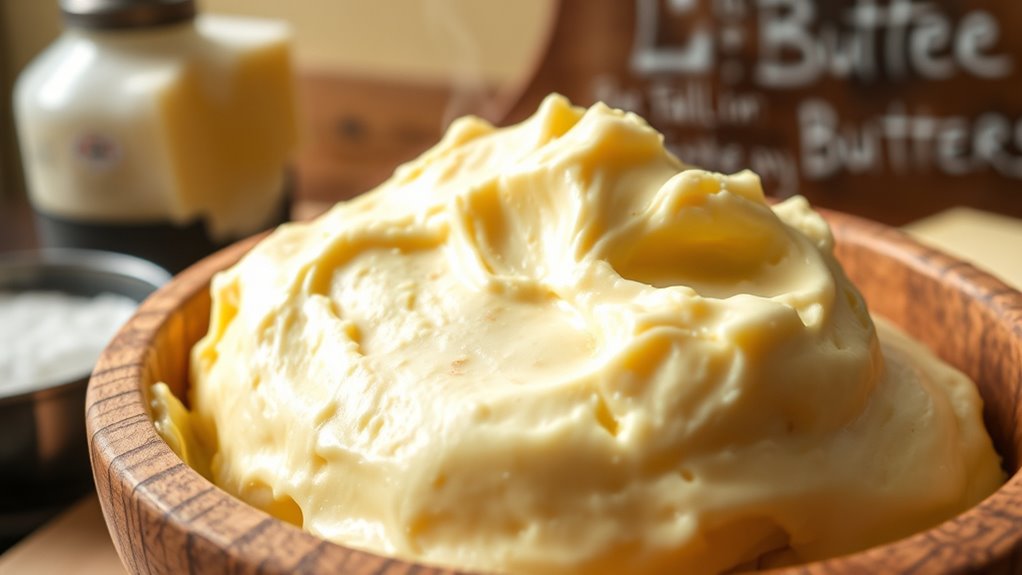
Using starter cultures can considerably extend the freshness of your butter and keep it safe to consume longer. They work by inhibiting the growth of harmful pathogens, reducing the risk of spoilage. As a result, your product stays stable and reliable for a wider shelf life. Incorporating proper identification codes can also help ensure secure and accurate transactions when distributing your product.
Extending Product Freshness
Enhancing the shelf life and safety of European butter relies heavily on the strategic use of beneficial cultures. These cultures influence butter aging, helping to preserve flavor and texture over time. They also produce natural preservatives that inhibit spoilage organisms, extending freshness. Remote hackathons facilitate collaboration among global teams, enabling the sharing of innovative techniques for culture development and application. Packaging technologies complement these efforts by creating barriers against oxygen and moisture, further slowing deterioration. Proper packaging maintains the integrity of the cultures and prevents contamination, ensuring your butter stays fresh longer. When combined, cultures and advanced packaging help you deliver a product that maintains its quality from production to consumption. This approach not only extends product freshness but also reduces waste and enhances consumer confidence in your butter’s safety and flavor.
Inhibiting Pathogen Growth
Beneficial cultures in European butter not only preserve flavor and texture but also play a vital role in safeguarding against harmful pathogens. By harnessing cultural diversity and advanced fermentation techniques, you can inhibit the growth of bacteria like Listeria or Salmonella, enhancing food safety. These cultures produce natural antimicrobial compounds that create an unfavorable environment for pathogens, reducing contamination risks. Fermentation techniques introduce beneficial bacteria that outcompete harmful microbes, extending the product’s safety window. This biological barrier is essential for maintaining high-quality butter without relying on artificial preservatives. Understanding fermentation helps in selecting the appropriate starter cultures that effectively resist pathogen growth, ensuring a safer, more stable product for consumers and extending its shelf life naturally.
Improving Shelf Stability
Implementing specific starter cultures in European butter can considerably extend its shelf life and improve food safety. By leveraging molecular genetics, you can select strains with enhanced resistance to spoilage and pathogenic microbes. These cultures influence fermentation kinetics, ensuring rapid acidification that suppresses undesirable bacteria. Precise control over fermentation speeds up acid production, creating an environment that inhibits microbial growth and delays spoilage. Additionally, genetically informed strain selection allows for consistent performance across batches. As a result, the butter remains fresher longer and safer for consumers. Using molecular genetics and understanding fermentation kinetics together optimizes the stability of your product, reducing waste and boosting consumer confidence. This scientific approach guarantees your European-style butter maintains its quality during extended storage periods. Incorporating insights from fermentation kinetics can further fine-tune the process for optimal results.
Techniques for Incorporating Starter Cultures Into Butter Production
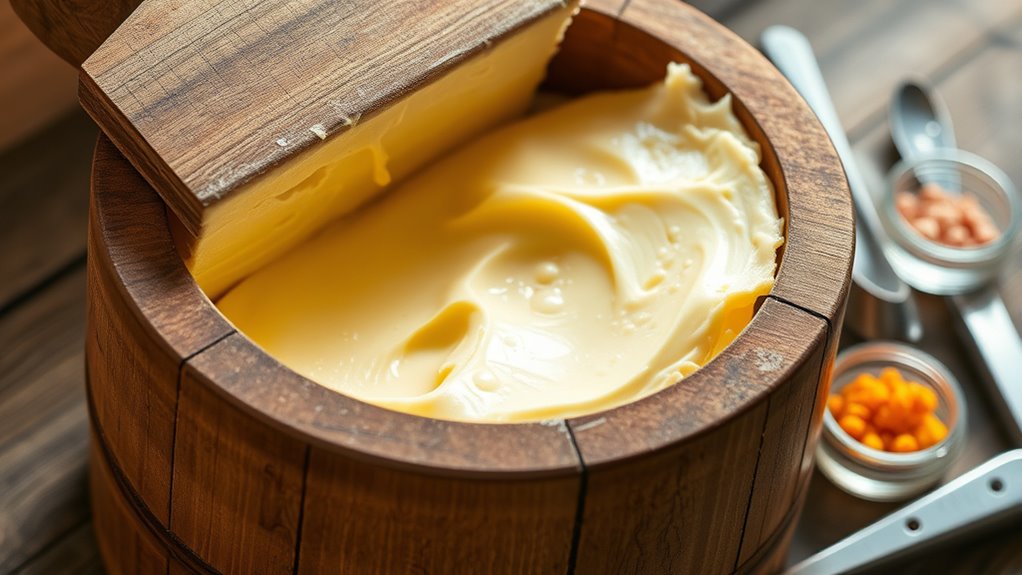
To effectively incorporate starter cultures into butter production, you need to carefully select the right method based on your equipment and desired flavor profile. First, you can add cultures directly to the cream before churning, allowing for even distribution. Second, you might introduce cultures during the ripening stage, enhancing flavor development and cultural preservation. Third, inoculate the churned butter by mixing in a small amount of cultured liquid for quick fermentation. Fourth, you can apply cultures via surface inoculation, creating a subtle, consistent flavor. These techniques help boost flavor enhancement while maintaining the cultural integrity of traditional European butter. By choosing the appropriate method, you guarantee the cultures develop properly, resulting in butter that reflects authentic taste and preserves its cultural heritage. Additionally, understanding how mindful decluttering can support efficient storage of ingredients and equipment ensures a more organized and effective production process.
Quality Control and Standardization With Microbial Cultures
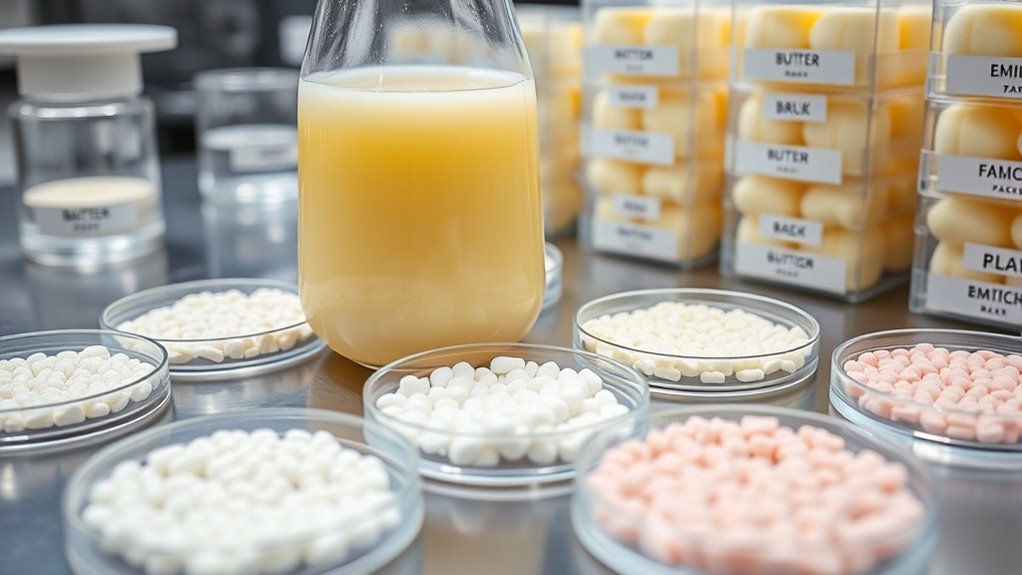
Ensuring consistent flavor in European butter depends on strict quality control of microbial cultures. You need to follow standardized procedures to maintain the desired microbial culture standards. This helps produce butter that meets quality expectations every time.
Consistency in Flavor
Maintaining consistent flavor in European butter relies heavily on effective quality control and standardization, which are achieved through the careful use of microbial cultures. These cultures ensure flavor consistency by stabilizing the fermentation process and preventing unwanted variations. To uphold microbial stability, you focus on:
- Selecting specific strains known for reliable flavor profiles
- Monitoring fermentation temperatures precisely
- Regularly testing cultures for purity and activity
- Adjusting culture quantities based on batch size and conditions
Microbial Culture Standards
Consistent quality in European butter depends on strict microbial culture standards that promote reliable fermentation outcomes. These microbial standards guarantee that the cultures used for cultured butter meet specific safety, purity, and potency criteria. By adhering to rigorous quality control measures, producers can guarantee the consistency of their starter cultures, which directly impacts the flavor, texture, and overall quality of the final product. Standardization helps prevent contamination and variability, ensuring each batch of cultured butter aligns with traditional standards. Proper microbial culture standards also facilitate research and development of new flavors or textures while maintaining safety. Ultimately, these standards serve as the foundation for producing high-quality European-style butter with predictable, desirable characteristics.
Innovations and Trends in Using Cultures for European-Style Butter

Recent innovations in using cultures for European-style butter are transforming traditional practices and opening new possibilities for flavor and texture development. You now see a blend of cultural influences shaping these trends, merging old and new. Historical practices inform modern techniques, but innovations push boundaries further. Imagine:
- Custom microbial blends that enhance regional flavors, echoing local terroirs.
- Probiotic cultures improving health benefits while adding subtle complexity.
- Fermentation time adjustments creating a richer, creamier texture.
- Hybrid cultures combining traditional and modern strains for unique sensory profiles.
- The application of microbial diversity in selecting cultures allows for more precise control over the final product’s characteristics.
These innovations reflect evolving consumer preferences and global influences, allowing artisans to experiment while respecting cultural origins. The use of cultures in European-style butter now balances heritage with cutting-edge science, elevating the craft to new levels.
Future Perspectives on Microbial Cultures in Artisanal Dairy Craftsmanship
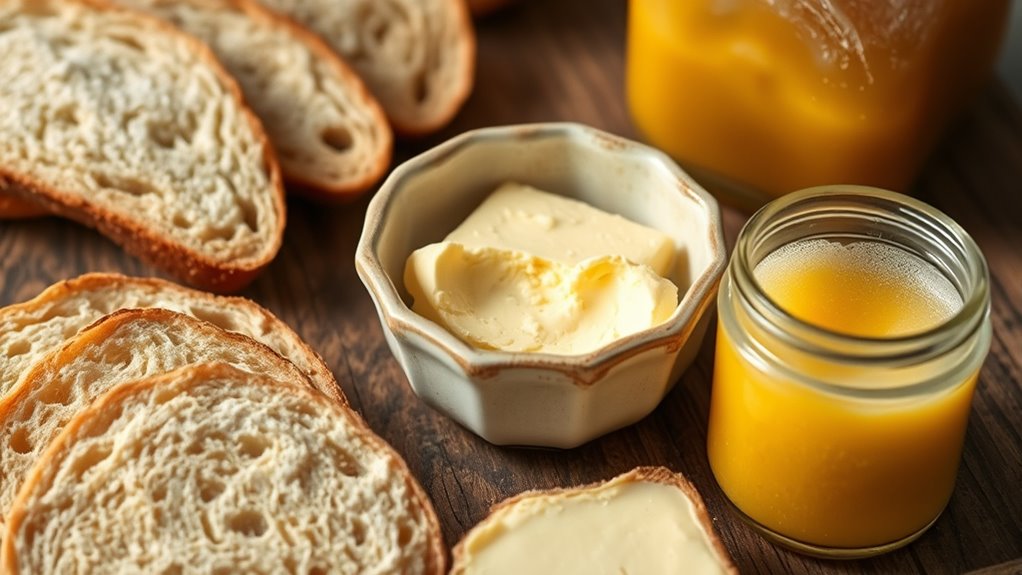
As artisanal dairy craftsmen look ahead, the future of microbial cultures promises to further revolutionize European-style butter, blending tradition with innovation. You’ll see a focus on cultural preservation, ensuring unique regional flavors remain authentic while embracing new techniques. Microbial cultures will play a crucial role in strengthening artisanal branding, helping producers differentiate their products in competitive markets. Advances in selective cultures and genome research will enable you to craft butters with consistent quality and distinct characteristics, honoring heritage while appealing to modern consumers. Additionally, sustainable practices and natural fermentation methods will become more prominent, aligning with consumers’ desire for authentic, eco-friendly products. This evolution will empower you to uphold artisanal craftsmanship, celebrate local traditions, and innovate creatively, securing the future of European-style butter.
Frequently Asked Questions
How Do Starter Cultures Influence the Nutritional Profile of Butter?
Starter cultures influence the nutritional profile of butter through microbial modulation, which can enhance its nutritional value. By introducing specific bacteria, you promote fermentation processes that increase beneficial compounds like vitamins and antioxidants. This microbial activity can also reduce undesirable fats, improving the butter’s health benefits. Overall, starter cultures enable you to achieve nutritional enhancement, making your butter not only tastier but also more nutritious.
Are There Regional Differences in Starter Culture Selection for European-Style Butter?
Regional preferences and cultural traditions definitely dictate starter culture choices for European-style butter. You’ll notice differences, as certain regions favor specific microbes that give their butter unique flavors and textures. These choices reflect local dairy practices, climate, and heritage. So, when you explore European butters, you’re tasting the traditions and tastes that have been passed down through generations, shaped by regional preferences that influence the starter cultures used in the process.
Can Starter Cultures Be Used to Produce Flavored or Specialty Butters?
You can absolutely use starter cultures to produce flavored or specialty butters. They enable flavor enhancement by introducing unique bacteria that develop distinctive tastes, and they can also assist with texture modification, making the butter creamier or more spreadable. By selecting specific cultures, you tailor the butter’s profile to create gourmet varieties, enhancing your product’s appeal and diversifying your offerings in the marketplace.
What Are the Environmental Impacts of Using Microbial Starter Cultures?
Using microbial starter cultures has environmental benefits, such as reducing waste and energy use during production. They promote microbial diversity, which can improve fermentation efficiency and lower reliance on chemical preservatives. By utilizing natural microbes, you help minimize chemical runoff and pollution. This sustainable approach supports healthier ecosystems, preserves biodiversity, and aligns with eco-friendly practices in butter manufacturing. Overall, starter cultures contribute to a greener, more sustainable dairy industry.
How Do Starter Cultures Affect the Allergenicity of Butter Products?
Think of starter cultures as tiny chefs in your butter, quietly transforming ingredients. They can help with allergen reduction by breaking down proteins that cause allergies, making the butter safer for sensitive eaters. Through microbial modification, these cultures fine-tune the dairy, reducing allergenic components. So, by choosing the right cultures, you’re not just crafting butter—you’re tailoring it to be more inclusive and less likely to trigger allergic reactions.
Conclusion
By understanding how starter cultures influence European-style butter, you can craft products with richer flavor, better texture, and longer shelf life. Did you know that using specific cultures can increase butter’s antioxidant properties by up to 30%? Embracing these microbial techniques not only elevates your craftsmanship but also meets growing consumer demand for high-quality, artisanal dairy. Keep exploring innovative cultures to stay ahead in this dynamic, flavorful industry.
